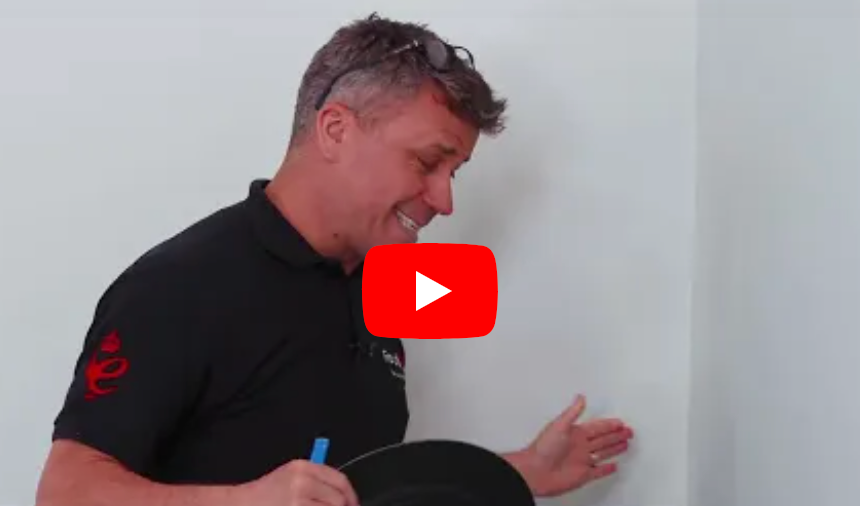How to Paint Newly Plastered Walls
If your interiors feel a little lacklustre, plastering and painting your walls can breathe new life into your space. But how do you paint new plaster? And what about your woodwork?
In this post, we’ll share insider tips and tricks for a flawless finish from our Brand Ambassador Craig Phillips, including how to prepare your surfaces and the best techniques for painting newly plastered walls and woodwork.
What you’ll need for painting plaster
- Sugar Soap
- Sandpaper
- Paint (Craig uses Sage Froth Chalk Wall Paint and Wise Old Sage Al Fresco Paint)
- Filler
- Paintable caulk
- Paintbrushes
- Roller and paint tray
- Small handheld paint sprayer (optional)
- Dust mask
- Safety glasses
- Masking tape
- Scissors
- Dust sheets (drop cloths)
- Hoover
Preparing newly plastered walls
Preparation is key to a perfect finish, so resist the temptation to skip this step. It is really worth the effort of sanding and cleaning to ensure you get a great final result.
First and foremost, let the plaster dry. Paint won't adhere properly to wet plaster, so make sure it's fully dried. This takes around 3-5 days for overskim or 4-6 weeks for a new plaster wall, though it can take longer depending on humidity and ventilation.
Don't paint directly over new plaster walls because the glossy surface can prevent the paint from adhering effectively. Instead, once you've protected your work area with dust sheets, lightly score the walls with 150-grade sandpaper to create a key and improve adhesion. Fill any holes and cracks with a premium filler, then sand away the excess.
When decorating with paint, you want sharp lines for a professional finish – that's where caulk can help. Run your gun from top to bottom along the corners of your room, where the walls meet. Then, do the same along the skirting boards, where the woodwork meets the fresh plaster. Once applied, smooth the paste with a clean, wet finger.
If you're decorating a bedroom, living room or dining room, we recommend using caulk rather than silicone sealant. Silicone sealant is water-resistant and better for high moisture areas, like bathrooms and kitchens, but you can't paint over it. In contrast, you can paint over caulk for a seamless aesthetic.
Now you have prepared your plaster walls, wipe them down with a damp cloth to remove any dust. Finally, suck up dust that has accumulated on the skirting, door frames and floor.
Preparing your woodwork
Preparing the woodwork around new plaster is an equally important step before you start painting. Woodwork includes skirting, dado rails, doors and window frames.
For previously painted woodwork, start by cleaning surfaces with Sugar Soap and water, then rinse, dry and lightly sand. Like new plaster walls, this will mean the surface is in the perfect condition to maximise adherence. Finally, you can apply more paintable caulk around the woodwork's edges.
Preparing your paint with a mist coat
Craig uses two application methods in the video above – a paintbrush and paint roller and a small handheld paint sprayer. Both require similar paint prep work.
When using a paintbrush and roller, dilute the first coat of paint. This is known as a mist coat, which helps the paint to penetrate the new plaster. With Frenchic Chalk Wall Paint, add 5-10% tap water to thin for your mist coat – make sure you stir well so it's evenly combined before applying.
When you apply a mist coat, you'll prevent the freshly plastered wall from absorbing too much of your paint, ensuring an even finish further down the line. This does the same job as primer on a newly plastered wall.
You don't need to dilute the paint for subsequent coats, or if your walls are already painted, because you don’t need to worry about absorbency.
When using a sprayer, you may need a thinner consistency, depending on your sprayer. Dilute with 10% tap water and test the spray is good on a spare piece of cardboard before starting.
How to paint new plaster walls with a brush and roller
Craig uses Frenchic Chalk Wall Paint in Sage Froth to paint the walls. The soft, light tones are perfect for uplifting dark spaces. Plus, green brings the outside in for an enhanced sense of wellbeing.
Use your paintbrush to cut in around the corners, frames and skirting. At this point, you don't have to be too meticulous. Cover the entire wall of new plaster and go onto the woodwork to disguise any filler. Once you've finished, you can neatly cut in, potentially with a different colour if you are using one.
If you're not painting your woodwork, use masking tape along the edges instead. You can also mask light switches and plug sockets if you want to ensure they're kept paint-free.
Now, get ready to roll. Thoroughly and evenly coat your roller with paint, but avoid submerging it as this can lead to overloading which causes drip marks and splashbacks.
In the video, Craig demonstrates his expert rolling technique. Most people start in the corner and go up and down while moving across the wall. However, as Craig points out, this doesn't spread the paint evenly.
He suggests starting in the corner, rolling up, rolling down and across, and then up again. Then, he moves down and across to create a cross. Afterwards, he rolls up and down to cover the area, applying gentle pressure as he goes. At this point, it’s well worth checking out the video – head to 5:30 to see the magic happen!
Once the walls are completely dry, you can apply the next coat following the same technique. Most paints will require more than one coat - it's best to follow the manufacturer's instructions on the paint tin for both coats and coverage rates.
Painting new plaster with a handheld sprayer
If you're short on time, use a nifty handheld paint sprayer. It's a speedy way to achieve a professional finish. However, always wear PPE, including a dust mask and safety glasses, and make sure your area is well ventilated.
Before spraying your new plaster, test your set-up on a piece of cardboard. You can adjust the nozzle for a narrow or wide pass-over. You might prefer to spray horizontally or vertically. Once you're happy with the effect, move on to your walls.
Hold the nozzle about four to six inches away from the surface. Craig sprays from top to bottom for his first layer, then left to right for his second. Leave your first coat to fully dry for at least two hours before applying another coat.
Painting wooden surfaces
Once the paint on the plaster is completely dry, turn your attention to the woodwork. Craig recommends starting with the high points and working your way down, just in case any paint drips. He also suggests completing the doors and doorframes first because it's best to get heavy traffic areas fully dry as soon as possible.
What paint should you use? Craig uses Al Fresco Paint in Wise Old Sage – not only is it exceptionally hard-wearing, but you don't need a primer or undercoat. It also dries flat with an ultra-modern matte finish.
The same qualities are available with our Lazy Range, or opt for our Trim Paint range for a subtle satin sheen and the option to colour match with any of our Chalk Wall Paints – which are also suitable for woodwork themselves.
A 750ml tin provides a single coat for up to 12.5 square metres. However, you need a minimum of two coats for durability, meaning your tin should provide full coverage for just over six square metres.
Painting doors and frames
Painting the door and door frame is one of the fiddliest jobs, but Craig breaks it down into digestible chunks. Start with the architrave around the door frame, covering the main face and going on to the door itself.
Then, cut in around the hinges and architrave. If you're confident with your brush, you can do this freehand. Otherwise, use masking tape to protect the plasterwork. As you cut in, you might find paint splashing back onto the front of the frame. To remedy this, lightly brush out any lumps and bumps with your paintbrush.
In the video, Craig paints a six-panelled door. Although the detail, wood grain and counter-sunk mitred edges look fantastic, they're pesky drip hazards for experienced and inexperienced DIYers alike. The solution? When painting the panels, constantly feather paint away from the corners, and always go with the grain where possible. Complete all the panels before tackling the rest of the door.
Next, Craig turns his attention to the space between the panels. Apply paint and continue to move with the wood grain. While you don't want to overload your paintbrush, keep topping up regularly to avoid spreading the paint too thin. Feather the paint in both directions where the wood grains meet. Finally, paint the long strips outside the panels, following the same method, and open the door while it's still wet to paint the visible inside edges.
Once dry, apply the second coat in the same order, starting with the panels and moving outward.
Painting skirting boards
While you wait for the first coat of paint to dry on the door, head to the skirting. If you're a beginner, you might find it helpful to protect the floors and plasterwork with a low-tack masking tape, and tightly tape your dust sheets onto the floor, against the bottom of the board.
Apply plenty of paint to your brush and start with the face of the board. Then, work your way closer to the cutting point where the woodwork meets the fresh plaster.
When painting the board's top lip, Craig holds the brush high, points it down and applies pressure to cover the edges. Your first coat doesn't have to be perfectly neat. The most important thing is to spread the paint evenly and keep your area dust free with an old paintbrush.
Before applying your second coat, assess the cutting line between the board and the plasterwork. If you're happy, continue to cut in freehand. Otherwise, stick low-impact masking tape along the wall, about a millimetre above your painted line. Paint over the tape, then remove it while wet for deliciously crisp lines.
Choosing the right paint for your walls and woodwork
Ready to roll, brush or spray? Whatever method of application you choose, Frenchic paint can provide an excellent result. Choose from a selection of products perfect for decorating one wall or your entire room, boasting unbeatable durability and self-sealing properties.
Best of all, there's a wealth of beautiful colours to browse, including timeless neutrals, pretty pastels and bold primaries. View the complete collection online, pick your favourites, then get painting!








